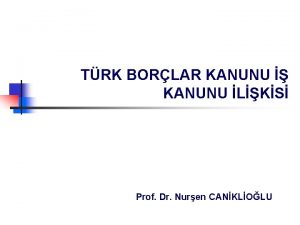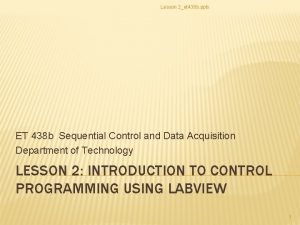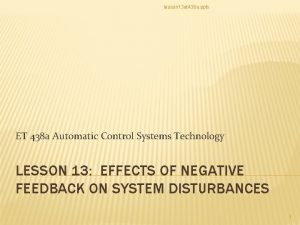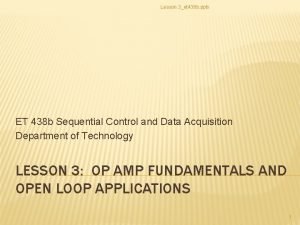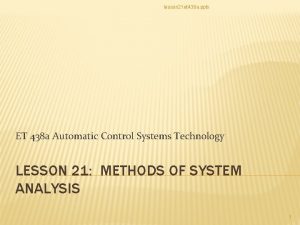J Gen Plant Pathol 2008 74 438 442





- Slides: 5

J Gen Plant Pathol (2008) 74: 438– 442 DOI 10. 1007/s 10327 -008 -0122 -4 VIRAL AND VIROID DISEASES First report of Bean common mosaic virus in yam bean [Pachyrhizus erosus (L. ) Urban] in Indonesia Tri Asmira Damayanti Æ Desmiarti Susilo Æ Siti Nurlaelah Æ Dewi Sartiami Æ Tetsuro Okuno Æ Kazuyuki Mise Received: 20 April 2008 / Accepted: 13 August 2008 / Published online: 16 October 2008 Ó The Phytopathological Society of Japan and Springer 2008 Abstract Severe mosaic with leaf malformation and green vein banding was observed on yam bean in West and Central Java, Indonesia. Virions of the causal virus were flexuous filaments, about 700 nm in length, with a coat protein of 30 k. Da. The virus was transmitted by mechanical inoculation and by aphids in a nonpersistent manner. The nucleotide sequence of the coat protein gene had the highest identity with that of Bean common mosaic virus (BCMV, genus Potyvirus) isolate VN/BB 2 -5. Based on demarcation criteria, including the genome sequence and host range, we tentatively designate this isolate as BCMVIYbn (Indonesian yam bean). Keywords Nucleotide sequence Á Bean common mosaic virus Á Pachyrhizus erosus Á Potyvirus Yam bean [Pachyrhizus erosus (L. ) Urban, Fabaceae], a horticultural crop in several areas of Indonesia, is used in Indonesia as fruit salads and cosmetic materials. The seeds and leaves are also used as botanical insecticides. Besides The nucleotide sequence reported is available in the DDBJ/EMBL/ Gen. Bank databases under accession number AB 289438. T. A. Damayanti (&) Á D. Susilo Á S. Nurlaelah Á D. Sartiami Department of Plant Protection, Faculty of Agriculture, Bogor Agricultural University, Jl. Kamper, Darmaga Campus, Bogor 16680, Indonesia e-mail: triadys@yahoo. com T. Okuno Á K. Mise Laboratory of Plant Pathology, Graduate School of Agriculture, Kyoto University, Kyoto 606 -8502, Japan 123 these beneficial roles, the yam bean is a symbiont with nitrogen-fixing bacteria and can therefore act as a good source of nitrogen in the soil (Sorensen 1996). In June 2004, viral-disease-like symptoms were observed during a survey of many yam bean fields in Bogor, West Java, and Prembun, Central Java, in Indonesia. Mosaic symptoms with green vein banding and leaf malformation were frequently observed (Fig. 1), affecting 14– 100% of the plants in Bogor and 20– 100% in Prembun. A poty-like virus was inferred to be the possible cause of the viral-disease-like symptoms. Previously, Sorensen (1996) reported that a potyvirus, Bean common mosaic virus (BCMV) might become a serious problem locally on cultivated yam bean in Tonga, Costa Rica, Ecuador and Thailand. However, Sorenson (1996) did not describe the biological or molecular characteristics of the BCMV infecting yam bean. Since we had failed to find local lesion hosts to isolate the virus in preliminary studies, we first diagnosed a diseased plant serologically. Hereafter in this study, the virus source in all experiments except for some seed transmission tests was an infected single yam bean plant from a field in Bogor. The sap from the plant was serologically tested in an enzyme-linked immunosorbent assay (ELISA) using several antisera against viruses infecting legumes such as Cucumber mosaic virus (AS-0475; DSMZ, German Resource Center for Biological Material, Braunschweig, Germany), Cowpea aphid-borne mosaic virus (AS-0417; DSMZ), BCMV (AS-0159; DSMZ), Soybean mosaic virus (AS-0543; DSMZ) and Bean yellow mosaic virus (AS 0471; DSMZ) and nonlegume-infecting potyviruses such as Chili veinal mottle virus (AS-0122; DSMZ), Turnip mosaic virus (AS-0132; DSMZ), Papaya ringspot virus (PRSV, CAB-53500; Agdia, Elkhart, IN, USA) and Watermelon mosaic virus (WMV [synonyms Watermelon mosaic virus 2], CAB-54000; Agdia) and against the

439 J Gen Plant Pathol (2008) 74: 438– 442 Table 1 Host range of the virus isolated from yam bean, host symptoms after mechanical inoculation and results of ELISA Plant family/species Symptoms ELISAa Amaranthaceae Gomphrena globosa -/- ? Chenopodium amaranticolor -/- - C. quinoa -/- - Cucumis sativus cv. Venus -/- - C. melo cv. Honey dew -/- - Cucurbita maxima -/- - Phaseolus vulgaris -/M ? Vigna sinensis -/C ? V. unguiculata -/- - Arachis hypogaea cv. Gajah -/- - Pisum sativum -/MM ? Nicotiana tabacum cv. White Burley -/- - Lycopersicon esculentum cv. San Marino C/(C) (? ) Capsicum annuum cv. Bara -/- - Datura stramonium -/- - Physalis floridana -/- - Chenopodiaceae Compositae Ageratum conyzoides Cruciferaceae Brassica olearacea Cucurbitaceae Leguminosae Solanaceae On inoculated/upper leaves. C chlorosis, M mosaic, MM mild mosaic, - no symptoms, parentheses indicate occasional infection a Fig. 1 Symptoms on yam bean leaves infected with Bean common mosaic virus-IYbn. a Healthy leaf. b–d Infected leaves. b Malformed leaf with green vein banding. c, Mosaic. d Leaf distortion. e Symptoms on yam bean plants in the field tobamovirus Tobacco mosaic virus (AS-0041; DSMZ) and the comovirus Squash mosaic virus (CAB-26400; Agdia). We also used anti-potyvirus antiserum (AS-573/1 DSMZ). The sap was positive for anti-WMV 2 (CAB-54000) and anti-potyvirus (AS-573/1) antisera, but negative for the other antisera. In a preliminary host range test using WMV 2 indicator plants such as three species of cucurbits (listed in Table 1), Chenopodium amaranticolor, and C. quinoa, the virus did not infect those plants, suggesting that the causal agent of this mosaic disease in yam bean is a potyvirus apart from the ones we tested. Supporting this observation, WMV 2 is serologically related to most of the mosaic-inducing and necrotic-inducing strains of BCMV (Edwardson 1974; Morales and Bos 1988). Upper leaf tissues were assayed 1 month after inoculation. ELISA data were considered to be positive if the absorbance values of the tests were more than twice those of healthy plants After these serological tests, infected plant tissue was further used to inoculate a number of healthy yam bean plants. The infected tissues were also used for virion purification for electron microscopy and protein analysis, as an inoculum source for aphid transmission and host range tests, and for the extraction of total RNA for nucleotide sequencing of RT-PCR products unless otherwise stated. The morphology and size of the viral particles were examined by transmission electron microscopic (JEM 1010 JEOL, Tokyo, Japan) analysis of the purified virus after purification from infected leaves with the method of Berger and Shiel (1998). Electron microscopy confirmed the presence of potyvirus-like particles, with a flexuous filamentous morphology and about 700 nm in length (Fig. 2 a). The purified virus was dissociated and subjected to sodium dodecyl sulfate-polyacrylamide gel 123

440 (12. 5%) electrophoresis according to Laemmli (1970) and stained with Coomassie brilliant blue. The purified virus preparation produced a band of approximately 30 k. Da and a smaller protein band, which could have been a degradation product of the full-length coat protein, as observed for many potyviruses (Fig. 2 b). The virus preparation was then used to inoculate healthy yam bean plants, which led to mosaic symptoms on the plants, which were identical to the original symptoms on the field plants and the initial infected plant (data not shown). We tentatively designated this virus isolate as BCMVIYbn (Indonesian yam bean) because of the additional characteristics described next. Mechanical transmission was examined by inoculating healthy yam bean plants with the sap of infected yam bean plants. Aphid transmission was also tested with the following methods. Aphids (Aphis craccivora Koch, A. glycines Matsumura, and A. gossypii Glover) were identified using the identification key of Blackman and Eastop (2000). The aphids were starved for 1 h and allowed to feed for either 3 min or overnight on the diseased plants. After both periods of acquisition feeding, the viral symptoms were reproduced after the first inoculation feeding (30 min), but not after second and third feedings. These results indicated that the virus was efficiently transmitted mechanically and by all aphids tested in a nonpersistent manner. In a test of the efficiency of aphid transmission on ten yam bean plants for each aphid species, up to 100% of tested plants showed symptoms with transmission by A. craccivora and A. gossypii and 70% of those by A. glycines. The virus was reisolated from all symptomatic plants, confirmed either by ELISA as already described or RT-PCR as described later. Fig. 2 a Electron micrograph of purified virus particles negatively stained with 2% uranyl acetate. Bar 100 nm. b Sodium dodecyl sulfate-polyacrylamide gel electrophoresis of coat protein. Lane 1, Unstained protein molecular-weight marker; lane 2, Bean common mosaic virus-IYbn (arrowhead indicates the coat protein of 30 k. Da) 123 J Gen Plant Pathol (2008) 74: 438– 442 In seed transmission tests with two seed lots, one seed lot was harvested from the inoculum source obtained as described, and the other seed lot was from infected yam bean plants grown in the fields in Bogor. Each seed lot (100 seeds) was divided into ten composite samples of ten seeds each. Fourteen days after seeding, leaves were harvested and subjected to ELISA as described. In the first seed lot, one of ten composite samples was positive, while two of ten in the last seed lot were positive for BCMV-IYbn using anti-potyvirus antiserum (AS-573/1) (data not shown). These results suggest that BCMV-IYbn could be transmitted through seeds. Infected plants with typical severe mosaic symptoms and leaf malformations were used for mechanical inoculation with 0. 1 M phosphate buffer (p. H 7. 2). The host range for the virus was examined in a mechanical inoculation assay of plants belonging to 18 species from seven families. The inoculated plants were maintained for 4 weeks in a greenhouse until the typical symptoms appeared. In all plants assayed, the virus was detected serologically in the upper leaves with ELISA using the anti-potyvirus antiserum (AS-573/1). The host range and symptomatology of the virus are presented in Table 1. Thirteen species from six families were not infected at all by this virus, whereas five species from three families were systemically infected. Systemic infection occurred in Phaseolus vulgaris, Vigna sinensis, Pisum sativum, and occasionally in Lycopersicon esculentum and asymptomatically in Gomphrena globosa. No local lesions were formed on the inoculated leaves of any plant species tested. Total RNA was extracted from the infected yam bean plants with a total RNA extraction kit (Qiagen Sciences, Germantown, MD, USA). The c. DNA was synthesized with Super. Script III reverse transcriptase (Invitrogen, Carlsbad, CA, USA) using the primer M 4 T (50 -GTTTTCCCAGTCACGACTTTTTTTT-30 ) for the 30 terminal poly(A) sequences of potyviruses. The c. DNA was amplified by PCR using M 4 (50 -GTTTTCCCAGTCACGAC-30 ) and S-primer (50 -GGNAAYAAYAGYGGNCARCC-30 ; N = A, C, G, or T; Y = C or T; R = A or G), which was designed from the consensus sequence that encodes the conserved amino acid sequence GNNSGQP in the NIb region of the family Potyviridae (Chen et al. 2001). The 1. 7 -kb PCR products thus obtained were also detected when viral RNA extracted from purified virions was used as the template (data not shown). The PCR products were separated on 1% Sea. Plaque GTG agarose gels (Cambrex, Rockland, ME, USA) and purified using Wizard SV gel and PCR Clean-up System (Promega, Madison, WI, USA). The gel-purified DNA was directly subjected to nucleotide sequencing with an ABI 310 DNA sequencer (Applied Biosystems, Foster City, CA, USA). Additional appropriate primers were designed to sequence the coat protein (CP)

441 J Gen Plant Pathol (2008) 74: 438– 442 gene and the 30 untranslated region (UTR) of the viral genome. The nucleotide sequences of the CP gene and the 30 UTR of the viral genome were aligned with those of other potyviruses using the program Clustal W (Thompson et al. 1994), while sequence identities were calculated using ‘‘sequence identity matrix’’ option in the program Bio. Edit version 7. 05 (http: //www. mbio. ncsu. edu/Bio. Edit/bioedit. html). The phylogenetic tree was constructed from the Clustal W-aligned sequences using the program MEGA 4. 0 (Tamura et al. 2007) with the neighbor-joining method and Kimura 2 -parameter model to estimate the distances, and bootstrap support was estimated with 1, 000 replicates. The nucleotide sequences of both regions of the virus had the highest identities with those of BCMV isolate VN/BB 2 -5 (DQ 925422), which is reported to infect Phaseolus vulgaris (black bean) in Vietnam (Ha et al. 2008) (86. 5% identity to the CP nucleotide sequence, 91. 6% to the CP amino acid sequence, and 92. 9% to the 30 UTR sequence). The identities of the CP gene and the 30 UTR of the virus relative to those of other potyviruses were 59. 2– 74. 0% and 27. 7– 78. 8%, respectively (Table 2). According to Shukla and Ward (1989), the nucleotide sequence identity of the CP gene among strains of a certain potyvirus species was over 90%, whereas Frenkel et al. (1989) reported that the degree of identity in the nucleotide sequences of the 30 UTR between strains of certain potyvirus species was 83– 99% and distinct virus species have identities in the range of 39– 53%. Adams et al. (2005) reviewed numerous sequences for potyviruses and proposed that the demarcation for the optimal CP nucleotide sequence identity was 76– 77% and that for the CP amino acid sequence identity was 82% in the same potyvirus species. Both the nucleotide and amino acid sequences of the CP gene and the 30 UTR sequence were highly homologous to those of the BCMV strains (Table 2), especially BCMV isolate VN/BB 2 -5. The identities of the nucleotide sequences of the CP gene and the 30 UTR and the amino acid sequences of the CP of the yam-bean-infecting virus and BCMV isolate VN/BB 2 -5 were much higher than 77, 83, and 82%, respectively. In phylogenetic analyses based on the CP-nucleotide sequences, isolates of BCMV were grouped into two major clusters (Fig. 3). Isolates IYbn and VN/BB 2 -5 were in the same cluster, while other BCMV strains, represented by the peanut stripe (PSt) strain and the blackeye cowpea (Bl. C) strain, were grouped into another cluster. Based on the identities for the CP-coding region, VN/BB 2 -5 was distantly related to other viruses of the BCMV group (Ha et al. 2008). In addition, an ELISA of BCMV-IYbn showed that BCMV-IYbn reacted negatively to anti-BCMV-PSt antiserum (AS-0159; DSMZ) (data not shown). These results suggest that BCMV-IYbn as well as BCMV-VN/BB 2 -5 is Table 2 Percentage a sequence identity between the coat protein gene distantly related to other BCMV strains and could be and the 30 untranslated region (3 0 UTR) of the virus isolated from yam designated as a new potyvirus species based on the criteria beanb and those of other potyviruses by Adams et al. (2005). However, they also stated that for Virusc Coat proteind 30 UTR Gen. Bank accession potyvirus species identification, the CI gene, rather than the CP gene, is the best gene to determine potyvirus species. Nt aa Therefore, determination of the complete sequences of Az. MV 71. 1 73. 1 47. 8 U 60100 these isolates is required to clarify their relationships to BCMV-Bl. C-R 72. 1 74. 9 78. 8 AJ 312437 BCMV-Bl. C-VN/YB 1 72. 1 74. 9 77. 6 DQ 925424 BCMV-PSt 74. 0 76. 3 75. 0 X 63559 BCMV-PSt-I 14 BCMV-PSt-VN/SB 1 73. 8 73. 7 76. 6 76. 3 63. 1 74. 2 AJ 132157 DQ 925418 BCMV-VN/BB 2 -5 86. 5 91. 6 92. 9 DQ 925422 BYMV 59. 2 55. 1 27. 7 NC_003492 Cab. MV SMV 66. 5 69. 6 67. 8 75. 0 42. 6 59. 2 NC_004013 AY 294044 WMV 69. 7 72. 2 58. 2 AB 218280 94 100 100 99 Accession number of BCMV-IYbn is AB 289438 Az. MV Azuki bean mosaic virus (a member of BCMV), BCMV Bean common mosaic virus, BCMV-Bl. C blackeye cowpea strain, BCMVPSt peanut stripe strain, BCMV-VN/BB 2 -5 BCMV isolate VN/BB 2 -5, BYMV Bean yellow mosaic virus, Cab. MV Cowpea aphid-borne mosaic virus, SMV Soybean mosaic virus, WMV Watermelon mosaic virus d Nt nucleotide, aa amino acid BCMV-Bl. C-VN/YB 1 BCMV-Bl. C-R Az. MV BCMV-PSt-VN/SB 1 BCMV-PSt-I 14 BCMV-PSt BCMV-IYbn BCMV-VN/BB 2 -5 WMV SMV Cab. MV BYMV Sequence identities were calculated using ‘‘sequence identities matrix’’ option in Bio. Edit version 7. 05 c 100 96 77 a b 100 0. 05 Fig. 3 A phylogenetic tree based on the nucleotide sequences of the coat protein genes of the seven Bean common mosaic virus (BCMV) isolates and other potyviruses. The numbers at the branch node indicate the confidence values (%) from bootstrap analysis using 1, 000 replicates. Outgroup: Bean yellow mosaic virus (BYMV). See Table 2 for the Gen. Bank accession numbers of the viruses. BCMVIYbn is highlighted 123

442 other BCMV isolates as noted for BCMV-VN/BB 2 -5 (Ha et al. 2008). Experimental hosts for BCMV are predominantly legumes, although Arachis hypogaea and Pisum sativum are reported to be nonhosts (Morales and Bos 1988). Our findings differ somewhat from the general BCMV host ranges. The BCMV isolated from yam bean was able to infect P. sativum, occasionally induced systemic chlorosis in L. esculentum, and latently infected G. globosa. This report is the first on the occurrence of BCMV in yam bean, which causes severe mosaic, in Indonesia, and we named this isolate BCMV-IYbn (Indonesian yam bean). Acknowledgments We thank Endang Nurhayati for providing anti. WMV 2 and anti-Sq. MV antisera and Gede Suastika for anti-PRSV antiserum and Edi Supardi for assistance in preparation of the greenhouse trials. This work was supported by fundamental research grant from Indonesia Directorate General of Higher Education (IDGHE) No. 012/SP 2 H/PP/DP 2 M/III and research grant from The Academy of Sciences for the Developing World (TWAS) No. 06 -038 RG/BIO/AS. References Adams MJ, Antoniw JF, Fauquet CM (2005) Molecular criteria for genus and species discrimination within the family Potyviridae. Arch Virol 150: 459– 479 Berger PH, Shiel PJ (1998) Potyvirus isolation and extraction. In: Foster GD, Taylor SC (eds) Methods in molecular biology, plant virology protocols: from virus isolation to transgenic resistance, vol 81. Humana Press, Totowa, NJ, pp 151– 160 123 J Gen Plant Pathol (2008) 74: 438– 442 Blackman RL, Eastop VF (eds) (2000) Aphids on the world’s crops. An identification and information guide, 2 nd edn. Wiley, UK Chen J, Adams MJ (2001) A universal primer to detect members of Potyviridae and its use to examine the taxonomic status of several members of the family. Arch Virol 146: 757– 766 Edwardson JR (1974) Some properties of the potato virus-Y group. Fla Agric Exp Stn Monogr Ser No 4, p 398 Frenkel MJ, Ward CW, Shukla DD (1989) The use of 3 0 non-coding region nucleotide sequences in the taxonomy of potyviruses: application to watermelon mosaic virus 2 and soybean mosaic virus-N. J Gen Virol 70: 2775– 2783 Ha C, Revill P, Harding RM, Vu M, Dale JL (2008) Identification and sequence analysis of potyviruses infecting crops in Vietnam. Arch Virol 153: 45– 60 Laemmli UK (1970) Cleavage of structural proteins during the assembly of the head of bacteriophage T 4. Nature 227: 680– 685 Morales FJ, Bos L (1988) Bean common mosaic virus. http: //www. dpvweb. net/dpv/showdpv. php? dpvno=337 Shukla DD, Ward CW (1989) Identification and classification of potyviruses on the basis of coat protein sequence data and serology. Arch Virol 106: 171– 200 Sorensen M (1996) Yam bean (Pachyrhizus DC). Promoting the conservation and use of underutilized and neglected crops. 2. Institute of Plant Genetic and Crop Plant Research, Gatersleben/ International Plant Genetic Resource Institute, Rome Tamura K, Dudley J, Nei M, Kumar S (2007) MEGA 4: Molecular evolutionary genetics analysis (MEGA), version 4. 0. Mol Biol Evol 24: 1596– 1599 Thompson JD, Higgins DG, Gibson TJ (1994) CLUSTAL W: improving the sensitivity of progressive multiple sequence alignment through sequence weighting, position-specific gap penalties and weight matrix choice. Nucleic Acids Res 22: 4673– 4680




